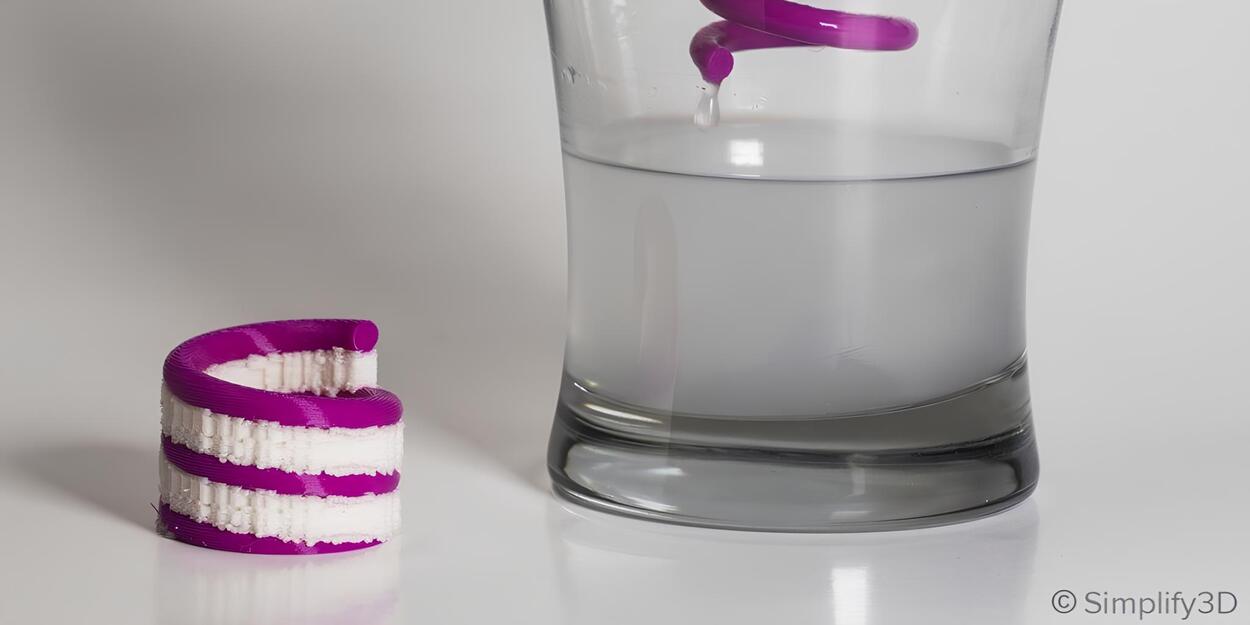Banner Image Courtesy of Simplify3D
What is PVA 3D Printer Filament?
Polyvinyl Alcohol (PVA) filament is a water‑soluble thermoplastic widely used in 3D printing, primarily as a support material for complex prints. Unlike standard filaments such as PLA or ABS, PVA’s unique property is that it dissolves completely in water, leaving the main printed object intact and smooth.
PVA Filament Key Features:
• Chemical composition: PVA is a synthetic polymer made by hydrolyzing polyvinyl acetate.
• Primary role: Support structures for overhangs, bridges, and intricate geometries.
• Compatibility: Often paired with dual‑extrusion printers, where one nozzle prints the main material (PLA, PETG, etc.) and the other prints PVA supports.
• Ease of removal: Supports can be dissolved without mechanical force, reducing the risk of damaging the main print.
PVA is especially valued in prototyping, engineering, and educational environments where precision and surface finish are critical.
Key Properties
|
Property |
Description |
Impact on Printing |
|
Water Solubility |
Fully dissolves in room‑temperature water |
Enables clean removal of supports |
|
Biodegradability |
Breaks down naturally in water over time |
Environmentally friendlier disposal |
|
Low Glass Transition Temperature (~85°C) |
Softens at relatively low heat |
Requires careful storage and printing temperature control |
|
Good Adhesion to PLA or PETG |
Bonds well during printing |
Prevents support detachment mid‑print |
|
Hygroscopic Nature |
Absorbs moisture from air |
Must be stored in airtight containers with desiccant |
Pros and Cons of PVA Filament
|
Pros |
Cons |
|
Supports can be placed in hard‑to‑reach areas without worrying about removal damage. |
Rapidly absorbs humidity, leading to print defects like bubbling or poor layer adhesion. |
|
Dissolves away without scraping or cutting. |
More expensive than standard filaments due to specialized production. |
|
Water solution can be filtered and disposed of responsibly. |
Even in sealed storage, PVA can degrade over months. |
|
Reliable dual‑material printing. |
Low mechanical strength and heat resistance. |
|
Demonstrates advanced 3D printing techniques without complex tools. |
Single‑nozzle printers can’t use PVA effectively. |
Recommended Printer Settings
|
Setting |
Recommended Range |
Notes |
|
Nozzle Temperature |
185–200°C |
Avoid overheating to prevent degradation |
|
Bed Temperature |
45–60°C |
Helps adhesion without warping |
|
Print Speed |
20–40 mm/s |
Slower speeds improve layer bonding |
|
Cooling Fan |
Moderate (50–70%) |
Prevents stringing but maintains adhesion |
|
Storage |
Airtight container with desiccant |
Essential to prevent moisture absorption |
* If PVA has absorbed moisture, you can dry it in a filament dryer at ~45°C for several hours before printing.
Top Applications
Support Material for Dual‑Extrusion Prints
Complex overhangs, bridges, and internal cavities. Ideal for architectural models, mechanical prototypes, and artistic sculptures.
Educational Demonstrations
Teaching advanced printing techniques. Showing how soluble supports work in real time.
Prototyping Functional Parts
Allows intricate designs without redesigning for manufacturability. Useful in R&D environments.
Medical Models
Printing anatomical structures with internal supports that dissolve away. Enables high‑fidelity replicas for surgical planning.
Art and Jewelry
Supports delicate designs without risk of breakage during removal.
How to Choose between HIPS and PVA As 3D Printing Supports
|
Feature |
PVA |
HIPS |
|
Solvent |
Water |
Limonene (organic solvent) |
|
Printer Compatibility |
Best with PLA or PETG |
Best with ABS |
|
Ease of Removal |
Very easy—just soak in water |
Requires chemical handling |
|
Environmental Impact |
Safer disposal |
Limonene disposal requires care |
|
Cost |
Higher |
Moderate |
|
Moisture Sensitivity |
High |
Low |
Choosing Tips
• If printing with PLA or PETG: Go with PVA for water‑based removal.
• If printing with ABS: HIPS is better due to material compatibility.
• If you want safer handling: PVA avoids chemical solvents.
• If budget is tight: HIPS may be more economical.
FAQs
Q: Can I use PVA with ABS?
A: Not recommended. PVA doesn’t adhere well to ABS and may cause support detachment. Use HIPS instead.
Q: How long does PVA take to dissolve?
A: Typically 1 to 24 hours depending on support size, water temperature, and agitation. Warm water speeds up the process.
Q: Is PVA filament toxic?
A: PVA is generally non‑toxic, but always follow the manufacturer's safety guidelines and avoid ingestion.
Q: How should I store PVA filament?
A: In an airtight container with silica gel packs. Avoid humid environments.
Q: Can I print PVA alone?
A: Yes, but it’s rarely done. It’s mechanically weak and intended for supports, not functional parts.














